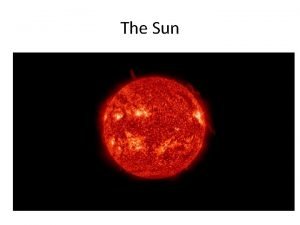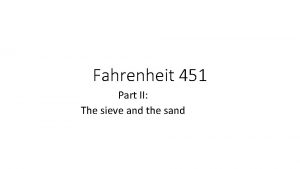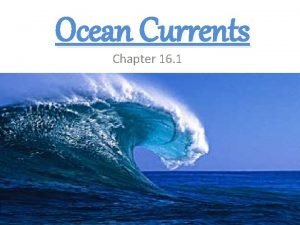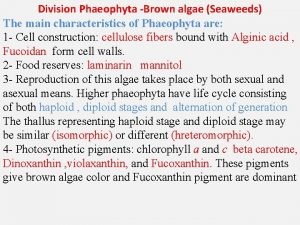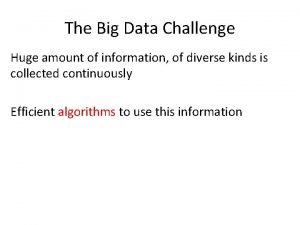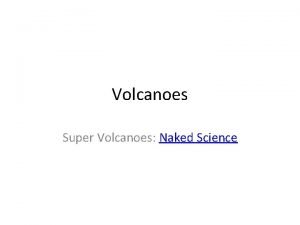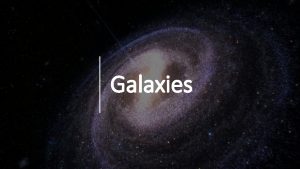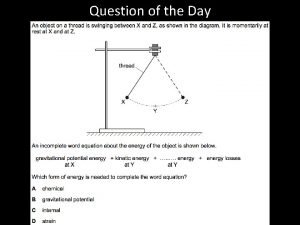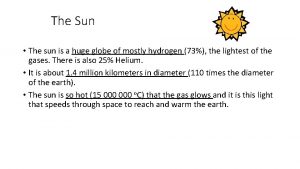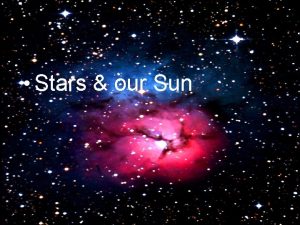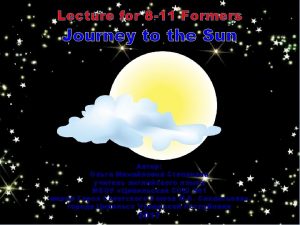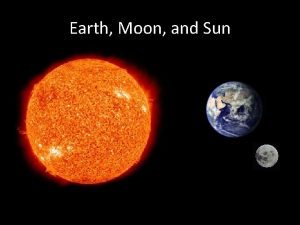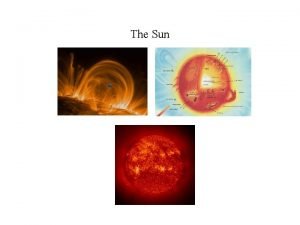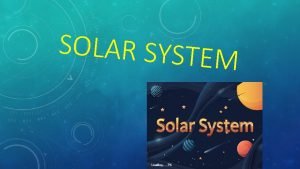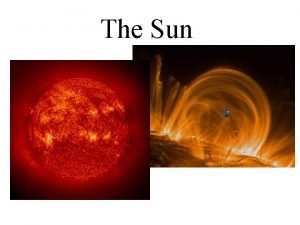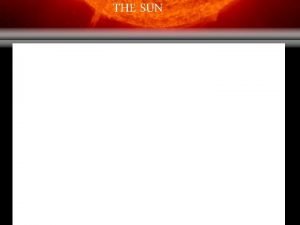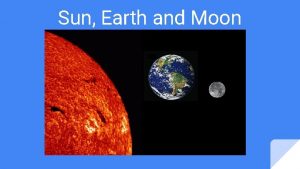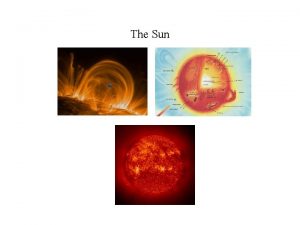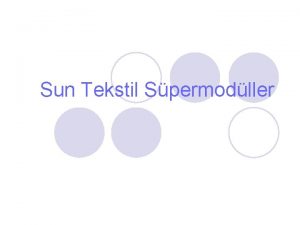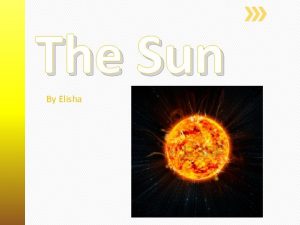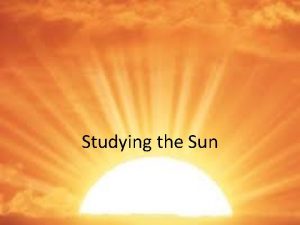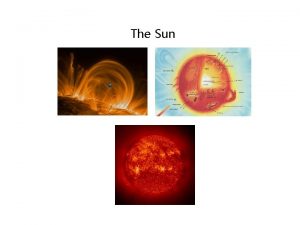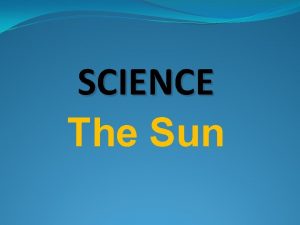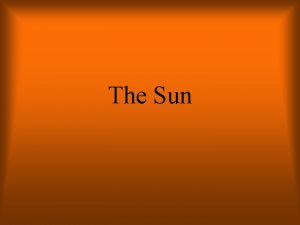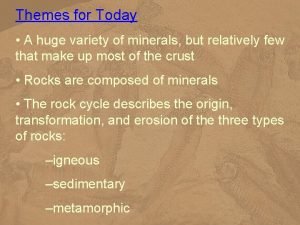The Sun The Sun is huge The Sun






























- Slides: 30

The Sun

The Sun is huge! • The Sun is a medium size star. • The Sun is 1000 times larger than Earth and contains more than 99% of the total mass of our solar system.


Inside the Sun • We can see the spots on Sun΄s surface. They are more cool (4500 K) than the surface (5800 K). The spots are disorders of the Sun΄s magnetic field. • From the inside to the surface, the Sun contains the core, the radiative zone, the convection zone and the Photosphere, the only visible zone of the Sun. All the light of the Sun is coming from there. More outside are the Chromosphere and the Corona.



The flares in the chromosphere

The corona

Back to the core of the Sun

Atoms are very small

The atoms, Hydrogen and Helium

The <magic> fusion

Fusion stops the gravitational collapse

Thermonuclear fusion and Sun’s life • Every second 564 millions tons of Hydrogen fuse into 560 millions tons of Helium in the core of the Sun. The <lost> 4 millions tons of matter converse into energy (radiation γ). • This energy stops the Sun’s gravitational collapse. • The fusion makes the Sun stable for many billions of Years.

The evolution of the Sun • The Sun was formed 4, 5 billions years ago and will exist other 4, 5 - 5 billion years. • When all the Hydrogen in the core will be fused into Helium, the fusion will go on in a layer outside the core. • The Sun will expand to Venus orbit. The surface temperature will drop, so the Sun will turn to a red giant.

The fusion in a red giant

The helium burning stage • When the temperature in the core reach 100 million K the Helium will fuse into Carbon. At an outside layer Hydrogen will fuse into Helium. • Now the star is loosing material through its very strong solar wind.

The death of the Sun • The Sun΄s remain will be a white dwarf, a very dense object, 100. 000 K hot. A fast expanding planetary nebular will form around the dwarf. • The matter of the planetary nebula will enrich the next stars generation with heavy elements. • Except Hydrogen and Helium, all the other elements are made in the stars.

The H/R diagram

The activity of the Sun • The activity of the Sun follows a cycle of 11 years. The magnetic field is trapped in the movement of the hot plasma. • We can see many Sun spots when the activity of the Sun is high. The Sun spots also are related to flares and coronal eruptions, jets of fast plasma that can escape the Sun.

Minimum and maximum activity



The solar wind • The solar wind are the particles of matter (mostly Hydrogen and Helium cores) from Sun΄s eruptions what are reaching Earth and the other planets. • The magnificent northern lights are the impact of the solar wind to Earths magnetic field and atmosphere.


Chemical elements in the Sun • We have discovered all chemical elements on the Sun. Hydrogen is the most common, also Helium, Carbon, Oxygen and Nitrogen. The elements heavier than Iron are very rare. • The nebular the Sun is coming from was already enriched (from remains of stars that did belong to an earlier generation) in elements and complex molecules. This is typical for a star on the Galaxy disk.

Our Sun in the Galaxy

The solar eclipse • The total solar eclipse is the most spectacular event we can see from Earth. • It happens almost every Year, but only in a very small area on the Earth. • The Sun is 400 times larger than the Moon, but also 400 times more far from Earth. So the Moon covers the Sun during the totality, and we can see the Chromosphere and the Corona, which are normally invisible.


 Which features of the sun look like huge cloud-like arches?
Which features of the sun look like huge cloud-like arches? The sun is a huge
The sun is a huge Maybe some of the sand will stay in the sieve
Maybe some of the sand will stay in the sieve Are huge circular moving current systems
Are huge circular moving current systems Henry c. gatz
Henry c. gatz Luminous ball of gases
Luminous ball of gases Mysql huge pages
Mysql huge pages A turtle is huge subject and predicate
A turtle is huge subject and predicate General characteristics of phaeophyta
General characteristics of phaeophyta Our earth is surrounded by a huge blanket of
Our earth is surrounded by a huge blanket of A huge amount of information
A huge amount of information Hakaluki haor fill in the blanks
Hakaluki haor fill in the blanks Storm on the island seamus heaney
Storm on the island seamus heaney Brilliant biome
Brilliant biome Montag external conflict with society
Montag external conflict with society What is a mountain
What is a mountain Largest galaxy
Largest galaxy Images of weather systems on television come from *
Images of weather systems on television come from * The kraken by alfred lord tennyson
The kraken by alfred lord tennyson Digital strategy case study
Digital strategy case study Large monuments created by huge stones
Large monuments created by huge stones Leiomyomatas
Leiomyomatas Adjacent noun
Adjacent noun Big huge labs
Big huge labs Huge surge artinya
Huge surge artinya A car on a roller coaster track launched by a huge spring
A car on a roller coaster track launched by a huge spring Khi nào hổ mẹ dạy hổ con săn mồi
Khi nào hổ mẹ dạy hổ con săn mồi điện thế nghỉ
điện thế nghỉ Một số thể thơ truyền thống
Một số thể thơ truyền thống Thế nào là sự mỏi cơ
Thế nào là sự mỏi cơ Trời xanh đây là của chúng ta thể thơ
Trời xanh đây là của chúng ta thể thơ

